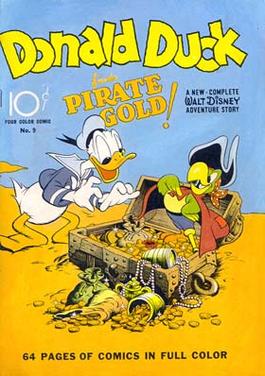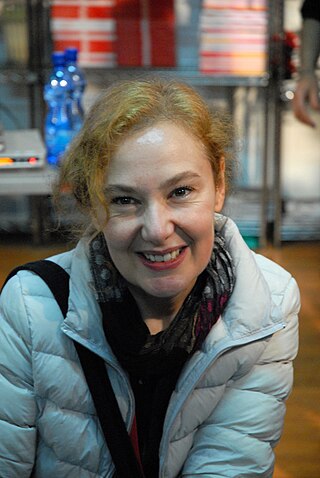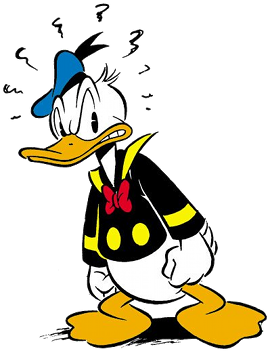
Daisy Duck is an American cartoon character created by the Walt Disney Company. As the girlfriend of Donald Duck, she is an anthropomorphic white duck that has large eyelashes and ruffled tail feathers around her lowest region to suggest a skirt. She is often seen wearing a hair bow, blouse, and heeled shoes. Daisy was introduced in the short film Mr. Duck Steps Out (1940) and was incorporated into Donald's comic stories several months later. Carl Barks, the screenwriter and lead storyboard artist for the film, was inspired by the 1937 short, Don Donald, that featured a Latin character named Donna Duck, to revive the concept of a female counterpart for Donald.

Romano Scarpa was one of the most famous Italian creators of Disney comics.
Disney comics are comic books and comic strips featuring characters created by the Walt Disney Company, including Mickey Mouse, Donald Duck and Scrooge McDuck.

"Donald Duck Finds Pirate Gold" is a Disney comics story starring Donald Duck that was originally printed in Four Color #9 in October 1942. The script was by Bob Karp and illustrated by Carl Barks and Jack Hannah. The story is significant for launching the first American Donald Duck adventure comic series, and for being Barks' first duck comics work.

Donald Duck, also known as Donald Duck and Friends, is an American Disney comic book series starring the character Donald Duck and published by various publishers from October 1942 to June 2017. As with many early Disney comics titles, Donald Duck began as individual issues of Dell Comics' Four Color one-shots series. It was published as its own regular series in November 1952, starting with issue #26.
Giovan Battista Carpi was a prolific Italian comics artist, illustrator, and teacher from Genoa.

Italian comics, also known as fumetto, plural form fumetti, are comics that originate in Italy. The most popular Italian comics have been translated into many languages. The term fumetto refers to the distinctive word balloons that contain the dialogue in comics.
Donald Duck, a cartoon character created by the Walt Disney Company, is today the star of dozens of comic-book and comic-strip stories published each month around the world. In many European countries, Donald is considered the lead character in Disney comics, more important and beloved than Mickey Mouse.

The International Network of Disney Universe Comic Knowers and Sources (I.N.D.U.C.K.S.) or Inducks is a freely available database aiming to index all Disney Universe comics ever printed in the world, created and maintained by both amateurs and professionals. It is an international project which provides indexes of around 130,000 Disney comic publications worldwide. It is distributed with its own licence.
The Donald Duck pocket books are a series of paperback-sized publications published in various European countries, featuring Disney comics.

Silvia Ziche is an Italian comic book artist and writer, known for her work in Disney comics for the Italian comic digest Topolino.

Kalle Anka & C:o is a Swedish weekly Disney comics magazine, published by Egmont. The 52-page comic, launched in September 1948, is the overall best-selling Swedish comic magazine. In the early years, the comic printed translated stories from the United States, including Walt Disney's Comics and Stories, Four Color and other Dell Comics Disney titles. As Disney comics production waned in the United States in the 1960s, Kalle Anka began printing more European-produced content, from Scandinavia and Italy. Now, Kalle Anka & C:o and its Scandinavian sister editions Anders And & Co. (Denmark) and Donald Duck & Co (Norway) are identical, apart from the language.
Topolino is an Italian digest-sized comic series featuring Disney comics. The series has had a long running history, first appearing in 1932 as a comics magazine. Since 2013, it has been published by Panini Comics.

Donald Duck is a cartoon character created by The Walt Disney Company. Donald is an anthropomorphic white duck with a yellow-orange bill, legs, and feet. He typically wears a sailor shirt and cap with a bow tie. Donald is known for his semi-intelligible speech and his mischievous, temperamental, and pompous personality. Along with his friend Mickey Mouse, Donald was included in TV Guide's list of the 50 greatest cartoon characters of all time in 2002, and has earned a star on the Hollywood Walk of Fame. He has appeared in more films than any other Disney character.
Notable events of 1969 in comics.

Paperinik, also known as PK (Italy), Superduck (UK), Duck Avenger (USA),) is a comic book-costumed vigilante, Donald Duck's alter ego.
Guido Martina was an Italian comic writer, documentarist and author. Martina is well known for his Disney comics stories, including the first of the "Disney Parodies" story "L'inferno di Topolino", and the creation of Paperinik, Donald Duck's superhero alter ego.
Giulio Ernesto Chierchini was an Italian comics writer and artist, mainly known for his Disney comics work. He was the oldest still active Disney creator shortly before his death.
Donald Duck and Other Adventures, also known as Paperino giornale, is a 1937–40 weekly Italian Disney comics magazine published by Mondadori. The comic was launched by Federico Pedrocchi, Mondadori's art director, as a companion to the existing weekly Topolino magazine. Paperino published 149 issues from 30 December 1937 to 26 October 1940, at which point it was merged with Topolino.










